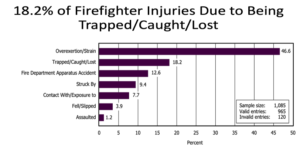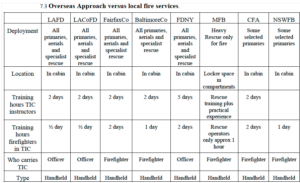Each year firefighters are injured and killed in structure fires. One of the common recommendations that could have prevented these injuries and deaths is the proper usage of thermal imaging cameras in these situations.

However, the following facts will be hard to fight against in a court of law when a municipality fails to provide these life saving devices and/or training:
The lack of TIC usage is the 6th ranked risk factor in firefighter line of duty deaths.
18.2% of all fire-ground injuries occurred from being lost or disoriented in a fire.
In the line of duty deaths that were studied up to 2010, the TIC was left on the charger of the fire truck in 38% of all these incidents.
NFPA 1408 (The thermal imaging training standard for firefighters) requires that the authority having jurisdiction shall provide training prior to placing these units in service, shall provide individual, team, and group training in classroom and live fire, and shall have written policies addressing training and usage of these devices during emergency incidents.
To reference this data, please refer to the following research papers:
Maximizing Thermal Imaging Usage in Emergency Services by Michael Whitty
In addition to this data, the work of Don Abbot’s Project MAY DAY shows the following:
22% of May Days Lost, Separated from Hose-line
Why Tactical TIC use should be understood & implemented:
(Maximizing Thermal Imaging Effectiveness) This report will make recommendations to various emergency services, with particular emphasis on the fire services. Among some of the key recommendations are:
All urban primary fire appliances should have at least one thermal imaging camera (TIC) with competent operators.
Firefighting TIC training must have a hot fire component.
Standard Operating Procedures (SOP) need to be modified to reflect TIC best practice utilization.
National Fire Protection Authority (NFPA) standard 1801 on TIC should be adopted as a selection criterion in future firefighting TIC purchases.
Specific features on TICs should be evaluated when considering the primary deployment of the camera – firefighting, overhaul, USAR, open area search, etc.
This research will show extensive proof exists that TIC usage by firefighters is a lifesaving technology. It has significant benefits to the occupational health and safety of responders and as such should be prioritized by fire service boards for implementation. It is without doubt a technology that will protect the most valuable asset a fire service has…its firefighters. (Whitty p. 3)
Lieutenant Jeff Parker pointed out in a recent article for Fire Engineering that not having a TIC at a structure fire was the 6th ranked risk factor in firefighter fatalities. NIOSH reports had identified that they had failed to be deployed in 38% of fatalities. Lieutenant Parker also pointed out that more than one TIC was required to be used to due the simultaneous needs on the fire ground of size-up, rescue and attack. He noted the need to move toward a TIC for each firefighter and lamented that “it is sad in today’s world to see firefighters still getting lost in smoke…When considered what we primarily deal with – total darkness and heat – the TIC should be a required tool for every firefighter.”
LODD NIOSH 1999-47: Six firefighters died when they became lost in a large cold storage building fire in Worcester. It was recommended that TIC be used to locate lost or downed firefighters and civilians.
LODD NIOSH 2007-18: Nine firefighters become disorientated and die in a rapidly progressing fire in a furniture showroom – Charleston, South Carolina. Another nine firefighters barely escaped suffering serious injury. Among many recommendations was for the use of TIC for size-up and the search for unaccounted firefighters.
LODD NIOSH F2004-10: Firefighter dies after becoming lost and entangled in a restaurant fire. The report recommended the correct training of firefighters so as not to become too reliant on TIC, to know TIC limitations, their positioning with a crew inside a structure and their need to be available for a rapid intervention search to locate a downed firefighter. (Whitty p.10).
http://www.esf.com.au/documents/reports/MichaelWhitty.2010.MFB.pdf
MAXIMISING
THERMAL IMAGING
USE IN THE EMERGENCY SERVICES
Regarding firefighter disorientation, firefighters who were equipped with a TIC and properly trained found their way out of as structure fire (after being lost and disoriented) 100% of the time.
See the following article for reference:
Preventing Firefighter Disorientation: Revisiting the Work of William Mora
US Firefighter Disorientation Study:
http://tkolb.net/FireReports/FirefighterDisorientationStudyJuly2003.pdf
If you wish to compare to other fire departments to justify the usage of thermal imaging cameras, please see the following chart attached to this post.

If you wish to provide more reasons for liability against the municipality for failing to provide such life saving devices, please see the following information:
Michael Whitty’s research paper posts the following information:The literature review also uncovered some research into quantifying the effectiveness of TIC use in searching for victims in a structure fire. The results indicate up to 75% reduction in time to locate a victim (civilian or downed firefighter) in a structure fire. The following summarizes some of this research.
In February 1999 issue of Fire-Rescue Magazine, the editor cited a nationwide study of the effectiveness of thermal imagers, carried out in 60 test burns around the country.
Without a thermal imager: 1) 60 percent of the time, firefighters were unable to locate the victim …With a thermal imager, 1) 99 percent of the time, firefighters were able to locate the victim, and 2) 100 percent of the time, firefighters found their way out of the burning house. The time required to satisfactorily complete a search with a thermal imager dropped by 75 percent.
The August/September 2001 issue of Advanced Rescue Technology included an article about a thermal imaging study conducted by the Johnson City Fire Bureau, Tennessee. Their research found that a victim search without a thermal imager took eight minutes, 38 seconds. With a thermal imager, the same victim search took three minutes, 30 seconds. Use of the thermal imager resulted in an increase of nearly 60 percent in search efficiency.
Chicago Fire Department Demonstration 6 During a news conference on May 27, 2003, at the Chicago Fire Academy, firefighters conducted a technical demonstration that illustrated the time rescuers save when they’re using thermal imagers. Without a thermal imager, firefighters spent 4 ½ minutes looking for a downed firefighter, this was reduced to 2 minutes 15 seconds with a thermal imager.
Burton, South Carolina Nine companies of firefighters in Burton, South Carolina conducted two sets of studies – one on the time required to find a fire and one on the time required to find a victim. Each drill was done with and without a thermal imager. Results: Without a thermal imager, the average time for all nine companies to find the room of fire involvement was four minutes, 48 seconds. With a thermal imager, the average time for all nine companies to find the fire was two minutes, 23 seconds (half the time). In the second set of tests, it took firefighters an average of six minutes, 46 seconds to find a victim without a thermal imager, and two minutes, 17 seconds to find a victim with the aid of the device (a 67% increase in effectiveness).
Fundamental firefighting skills are our foundation. May we learn to use technology as a force-multiplier to enhance our actions for the sake of the citizen.
Stay Intelligently Aggressive!
Insight Training LLC
Thermography Certified Fire Service Professionals
